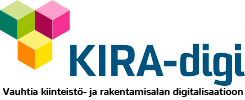Digitalisation Principles of Built Environment
1. Customer-oriented solutions and services
Solutions and services are above all made for the users. We test what the users want to achieve with the solution.
2. No unnecessary steps in the process
Communication between the companies and organisations is streamlined and eased. In the first place the customer has the opportunity to use electronic services.
3. The services built are safe and easy to use
Services are easy and safe to use with different devices. Specific needs of individuals, companies and organisations are taken into account.
4. Fast benefits to the customers
We find the most valuable features for the customer and start the development from these. Feedback on the service comes quickly. Time and money is saved. We learn by doing and testing.
5. Preparedness for emergencies and exceptional situations
We communicate on these clearly and accurately.
6. Making use of existing data and electronic services
We ask for new data only once. The development of services is cost-efficient. Among the services used is the National Architecture for Digital Services. We ensure that our services are available for others to use.
7. Data and interfaces are open to companies, organisations and individuals
As a rule data and interfaces are open, unless there are specific reasons for limiting the access. Data is shared to enable the creation of new, innovative services. Open access benefits everybody!
8. Data has a designated owner
During its whole life cycle data on the built environment has a designated owner who is responsible for keeping the data up-to-date and enables dialogue between various stakeholders.
9. International standards are followed
International standards are the basis for all development.
10. Legal force of decisions is linked to digital access
A zoning plan or decision will not gain legal force until it has been published in standard form through an open interface.
Rakennetun ympäristön digiperiaatteita on työstetty KIRA-digin strategisen johtoryhmän ja ohjausryhmän sekä kaikille avoimen joukkokyselyn voimin, ja ne pohjautuvat valtiovarainministeriön helmikuussa 2016 julkaistuihin julkisten palveluiden digitalisoinnin periaatteisiin. Periaatteet hyväksyi KIRA-digin strateginen johtoryhmä tammikuussa 2017.




